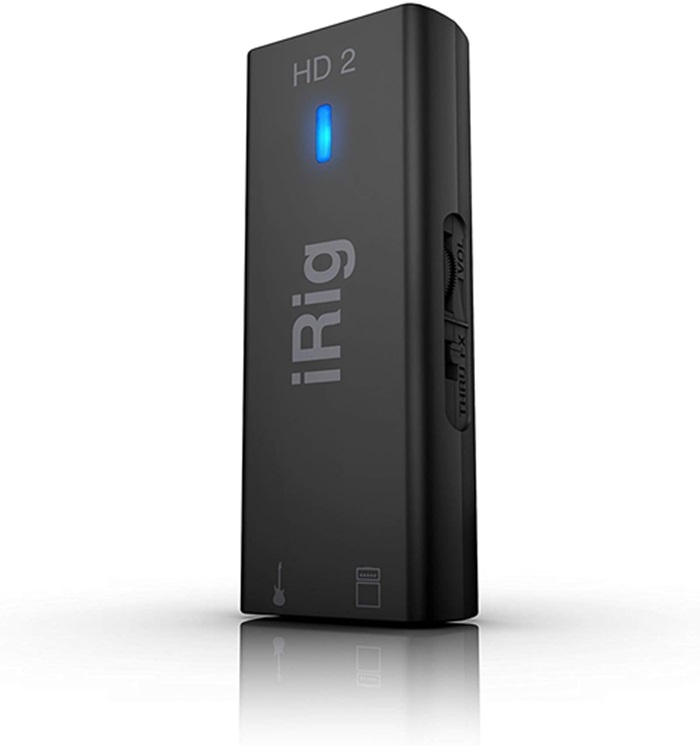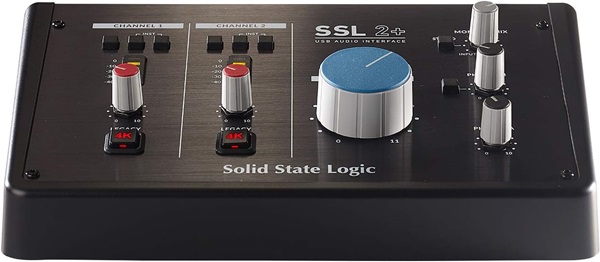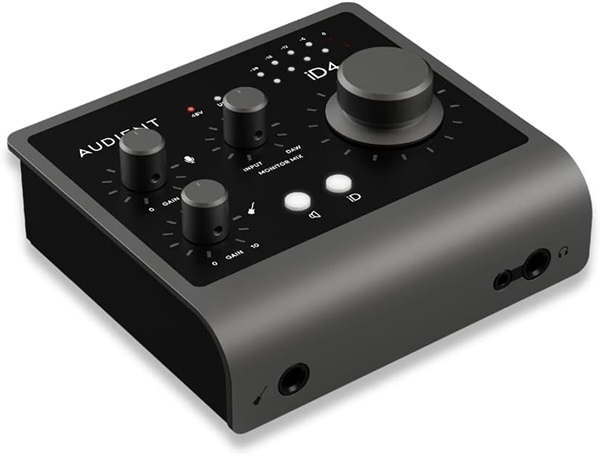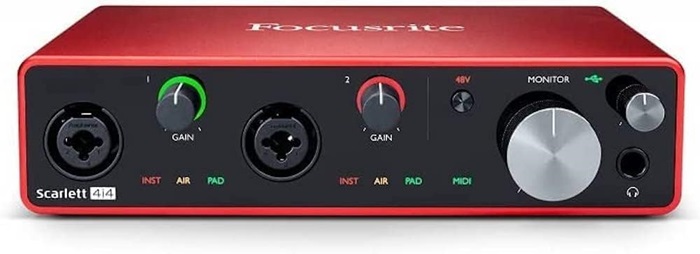Unlock Guitar Magic with Audio Interfaces!
No more struggles with delays – these audio interfaces for guitars make recording, adding effects, and creating music super easy. But before you dive into buying one, let’s check out the top three things you should keep an eye on.
- Input & Output Options: Look for a Hi-Z instrument input for your guitar.
- Sample Rate and Bit Depth: Check for higher sample rates (kHz) and bit depths (bits) for improved audio quality. Consider your recording needs and software compatibility.
- Compatibility and Connectivity: Ensure the interface is compatible with your guitar and devices. Check for suitable connectivity options like USB, Thunderbolt, or FireWire.
For a deep dive into all the details you need, we conducted thorough research based on your needs, and it’s all laid out in our “Buying Guide“. Below is the list of the best audio interfaces for guitars.
Also Check: Best Audio Interfaces for Drums
Best Audio Interface for Vocals
Outline
ToggleBest Audio Interfaces for Guitars Table
| Best Audio Interface for Guitars | Input Output | Sample Rate & Bit Depth | Compatibility | Connectivity | Buy Now |
|---|---|---|---|---|---|
| IK Multimedia Audio Interface | 1/4" Hi-Z Input and 1/4" Amp Out | 96kHz | iPhone, iPad, Mac, iOS and PC with USB-C | USB C | Check On Amazon |
| Solid State Logic Audio Interface | 2-In/4-Out | 192 kHz | Mac and PC laptops | USB | Check On Amazon |
| Audient Store Audio Interface | 1 x JFET Instrument Input 2 x Line Outputs 1 x Dual Headphone Output | 24bit / 96kHZ | Mac/PC/iOS | USB C | Check On Amazon |
| Focusrite Audio Interface | 4 Line Inputs, 2 High-Headroom Instrument Inputs, 4 Balanced Outputs | 24-bit/192kHz | Microphone, Keyboard, Personal Computer, Tablet, Headphone | USB C | Check On Amazon |
| Pyle Audio Interface | 4 XLR Microphone Inputs, 1/4’’ Mono + Stereo Inputs 2 1/4’’ (L/R) Outputs | - | - | Bluetooth | Check On Amazon |
Best Audio Interfaces for Guitars Reviews
1. IK Multimedia Audio Interface

iRig HD 2’s impressive 96kHz sampling rate – setting a benchmark in its class for distortion-free amplification. The integrated headphone output, complete with a preamp and level control, delivers an immersive practice environment without compromising performance. The adjustable input gain empowers musicians to fine-tune their sound, making the iRig HD 2 not merely an interface but a high-quality guitar preamp.
The iRig HD 2 seamlessly integrates with various devices, connecting directly to Lightning, USB-C, or USB ports. iRig HD 2 becomes a creative hub with support for popular software such as AmpliTube iOS and AmpliTube 4 for Mac/PC.
Technical Specifications:
| Features | Description |
| Input and Output Options | – 1/4″ Hi-Z Input Jack for instruments |
| – 1/4″ Amp Out Jack with switchable “FX” and “Thru” outputs for versatile connections | |
| MIDI, Preamps, Audio Quality, Resolution | – Distortion-free amplification with a 96kHz sampling rate |
| – Headphone output with preamp and level control for silent practice sessions | |
| – Adjustable input gain for fine-tuning the sound | |
| Supported Software | – Direct connection to Lightning, USB-C, and USB devices for iPhones, iPads, Macs, and PCs |
| Connectivity | – Compatibility with AmpliTube iOS and AmpliTube 4 for Mac/PC |
Pros:
- Switchable “FX” and “Thru” outputs for Amp Out Jack
- Distortion-free amplification
- Impressive 96kHz sampling rate
- Seamless Connectivity
- Compact design for easy portability
Cons:
- Single Channel
- External Power Requirement
- Compatibility issues with certain devices or software versions
2. Solid State Logic Audio Interface

SSL2+ has advanced features catering to professional audio needs. Two SSL-designed microphone preamps not only deliver remarkable noise performance but also provide an exceptional gain range, ensuring optimal clarity in recordings. The integration of Legacy 4K introduces analog warmth reminiscent of SSL’s legendary consoles, enriching the audio with a classic vibe. The focus on high-quality sound ensures an immersive experience, making SSL2+ a powerful tool for capturing audio with depth and detail.
In terms of connectivity, SSL2+ features a USB 2.0 interface, compatible with both Mac and PC laptops. Its bus-powered functionality enhances portability by eliminating the need for an external power supply. Bundled with the SSL Production Pack software, provided free with registered SSL 2 and SSL 2+ audio interfaces, it includes essential tools for music creation and media production.
Technical Specifications:
| Features | Description |
| Connectivity Technology | USB |
| Number of Channels | 2 |
| Microphone Preamps | 2 SSL-designed preamps |
| Analog Enhancement | Legacy 4K |
| Headphone Outputs | 2 professional-grade headphone outputs |
| Power Source | USB 2.0, bus-powered |
| Audio Interface Type | 2-In/4-Out USB Audio Interface |
Pros:
- Excellent noise performance.
- Compact and portable design.
- Professional headphone outputs
- Bus-powered via USB 2.0, no external power needed.
Cons:
- Limited to 2 channels.
- No built-in external power option.
- Limited onboard effects.
3. Audient Store Audio Interface

Audient Audio Interface stands out with its Unison mic preamps, delivering stunning models of classic tube and transformer-based mic preamps and guitar amps. The elite-class A/D and D/A conversion, derived from Apollo X rackmount interfaces, ensures impeccable audio quality. With UAD DUO Core Processing, the interface offers near-zero latency tracking through vintage compressors, EQs, tape machines, mic preamps, and guitar amp plug-ins.
It features a USB-C interface, making it compatible with Mac, PC, and iOS devices. The comprehensive software support includes Pro Tools, Cubase, Ableton Live, and more, ensuring flexibility within popular digital audio workstations. The interface also integrates with the LUNA Recording System, providing a fully-immersive recording experience for Mac users.
Technical Specifications:
| Features | Description |
| Compatible Devices | Mac, PC, iOS |
| Supported Software | Pro, Pro Tools, Cubase, Ableton Live |
| Number of Channels | 8 |
| Preamps | 2 Unison Mic Preamps |
| A/D and D/A Conversion | Elite-class derived from Apollo X rackmount interfaces |
| UAD Processing | UAD DUO Core Processing for near-zero latency tracking |
| Monitor Functions | Mono, Mute, DIM, ALT monitor controls |
| Digital Input | Up to 8 channels via optical ADAT/SPDIF input |
| Hi-Z Instrument Input | Front-panel Unison-enabled Hi-Z instrument input |
| Headphone Outputs | 2 Professional-grade headphone outputs |
| Connectivity | USB-C |
Pros:
- Impeccable audio quality.
- Zero latency tracking with vintage plug-ins.
- Precise control.
- Versatile digital input options
- Front-panel Unison-enabled Hi-Z instrument input.
Cons:
- Requires a compatible device (Mac, PC, or iOS).
- Premium-priced
4. Focusrite Audio Interface

Equipped with two of the finest Scarlett 3rd Gen mic preamps, ensures pro-level performance. The switchable Air mode adds extra clarity to acoustic instruments and vocals, enhancing your recordings. The audio quality is top-notch, mixing at up to 24-bit/192kHz. This guarantees professional-sounding recordings with all the sonic details preserved for playback. The Hitmaker Expansion provides access to essential studio tools and software, including Antares Auto-Tune Access for precise pitch adjustment.
Designed to stand up to the demands of the road, the interface connects directly to Mac or PC via USB cable. It supports all major software, including Pro Tools, Cubase, Ableton Live, and more. The inclusion of Ableton Live Lite and a Three Month Avid Pro Tools Artist subscription, complete with a plugin bundle, adds further value for users looking to dive into their creative projects right away.
Technical Specifications:
| Features | Description |
| Compatible Devices | Microphone, Keyboard, Personal Computer, Tablet, Headphone |
| Supported Software | All the Software |
| Number of Channels | 4 |
| Preamps | 2 Scarlett 3rd Gen Mic Preamps with switchable Air mode |
| Line Inputs | 4 Balanced Line Inputs for synthesizers or line-level audio |
| Instrument Inputs | 2 High-Headroom Instrument Inputs for guitars and basses |
| Balanced Outputs | 4 Balanced Outputs for monitoring and effects sends |
| AD-DA Converters | High-Performance 24-bit/192kHz Converters |
| Playback Quality | Crystal Clear Playback in Studio Quality |
| Connectivity Options | USB-C |
Pros:
- Exceptional sound and material quality.
- Commended for great and quiet preamps suitable for field recording.
- Versatile Use
- High-quality audio recordings.
- Controls and Portability
Cons:
- Reports of a USB noise issue affecting recordings, requiring a specific USB cable for a solution.
5. Pyle Audio Interface

The mixer is equipped with high-quality preamps that enhance the signal from your microphones and instruments. Its +48V Phantom power supply ensures optimal performance for condenser microphones. The 24-Bit ADC DAC Converter guarantees exceptional audio resolution, capturing every nuance of your sound. Whether you’re recording or performing live, the 6-channel mixer maintains a commitment to top-notch audio quality.
The inclusion of a USB soundcard and audio interface allows effortless connection to your MAC or PC for recording purposes. The mixer supports universal digital audio file compatibility, including popular formats like MP3 and WAV. Connect and stream audio from external devices using the USB Flash Drive Reader and USB port for desktop connection.
Technical Specifications:
| Features | Description |
| Number of Channels | 6 |
| Connectivity Technology | USB |
| Input Channels | 4 XLR Microphone Inputs, 1/4’’ Mono + Stereo Inputs |
| Output Channels | 2 1/4’’ (L/R) Outputs, 1/4’’ Headphone Jack |
| Audio Resolution | 24-Bit ADC DAC Converter |
| Audio File Compatibility | MP3, WAV |
| Preamps | High-Quality Preamps with +48V Phantom Power |
| Frequency Response | 20Hz-20kHz, +/-3dB |
| Distortion | 0.03%, 1kHz/150mV Input |
Pros:
- Versatile Connectivity
- High-quality preamps,
- Supports MP3 and WAV formats.
Cons:
- Bluetooth range restricted to 15 ft.
- Relatively larger and heavier.
Buying Guide for Best Audio Interfaces for Guitars
1. Compatibility and Connectivity
Ensure that the audio interface you’re considering is compatible with your specific guitar and the devices you intend to connect it to. Look for interfaces with the appropriate inputs for your guitar type (electric, acoustic, etc.) and check that it has the necessary connectivity options for your computer or recording equipment. Common connections include USB, Thunderbolt, or FireWire.
2. Input and Output Options
When considering an audio interface, understanding the input and output options is crucial for meeting your specific recording and playback needs. Inputs determine how many audio sources you can connect to the interface simultaneously, while outputs dictate the flexibility for monitoring and routing signals. Consider the number and type of input options provided by the audio interface. For guitars, having at least one high-impedance instrument input (often labelled as Hi-Z) is crucial for preserving the guitar’s tone.
3. Sample Rate and Bit Depth
Check the audio interface’s sample rate and bit depth specifications. Higher sample rates (measured in kHz) and bit depths (measured in bits) generally result in better audio quality and more accurate recordings. While standard rates like 44.1kHz/16-bit are suitable for most applications, higher-end interfaces may offer 96kHz/24-bit or more. Consider your specific recording needs and the compatibility of your recording software with different sample rates and bit depths.
4. Preamp Quality
The quality of the preamps in the audio interface is crucial for capturing a clean and detailed guitar sound. Look for interfaces with high-quality preamps that provide sufficient gain and low noise. This becomes especially important if you’re using dynamic or ribbon microphones with your guitar setup.
5. Latency
When selecting an audio interface, it’s essential to consider its latency performance. Look for interfaces that explicitly mention low-latency monitoring capabilities. This often involves features such as:
- Hardware Monitoring: The ability to monitor the input signal directly through the interface before it reaches the computer, bypassing the processing delay of the digital audio workstation (DAW).
- Zero-Latency Monitoring: Some interfaces offer zero-latency monitoring by providing a direct path for the input signal to the output, bypassing the computer entirely. This is particularly beneficial for monitoring during recording.
- Low-Latency Drivers: Quality audio interfaces often come with optimizer drivers that reduce the processing time, minimizing latency. Checking for the availability and compatibility of such drivers is crucial.
Best Audio Interfaces for Guitars – FAQs
Ans: Step-by-Step Guide to Connecting Your Guitar to an Audio Interface:
* Gather your guitar, a 1/4-inch instrument cable, and an audio interface with an “Instrument” or “Hi-Z” input.
* Turn off your guitar and the audio interface to avoid unwanted noise.
* Find the input labeled “Instrument” or “Hi-Z” on your audio interface. This is where your guitar will connect.
* Plug one end of the instrument cable into your guitar’s 1/4-inch output jack, ensuring a secure connection.
* Plug the other end of the cable into the “Instrument” or “Hi-Z” input on your audio interface.
* Turn on your audio interface, and if there’s a Hi-Z switch, activate it.
* Launch your recording software or DAW on your computer.
* In the software, choose the input corresponding to the instrument input on your audio interface.
* If your interface has gain control, set it to an appropriate level to avoid distortion.
* If available, turn on monitoring to hear your guitar in real-time with minimal delay.
* Strum your guitar and check for a clean, strong signal in the recording software. Adjust levels to prevent clipping.
You’re now set to use your guitar with the audio interface for recording, practicing, or live performance.
Ans: Yes, you can plug your guitar directly into your computer, but you’ll need an audio interface to facilitate the connection. The process involves using an instrument cable to connect your guitar to the audio interface, which is then connected to your computer via USB or another compatible port.
Ans: The guitar input, commonly known as a 1/4-inch input, uses a cable with a 1/4-inch connector. This type of connector is often referred to as a “quarter-inch” or “6.35mm” connector. It’s a standard size for connecting guitars and other musical instruments to amplifiers, audio interfaces, and other audio equipment.
Ans: You’ll need a standard instrument cable with a 1/4-inch (6.35mm) jack to connect your guitar to an audio interface.
Ans: An audio interface enhances the sound quality of your guitar recordings and allows for better control over input levels, minimizing latency for a more professional and detailed recording experience.
Conclusion
- For beginners and Solo Guitarists. IK Multimedia Audio Interface is the best choice. It provides a simple and straightforward solution for connecting a single audio source to a computer or recording device.
- For versatile inputs and live performers Pyle Audio Interface can benefit from the mixer’s 6 channels and 2 1/4’’ (L/R) outputs, providing flexibility for connecting various instruments and speakers.
- For high-performance audio interface Focusrite Audio Interface is an excellent choice. With multiple inputs and outputs for recording and monitoring various instruments and vocals.

